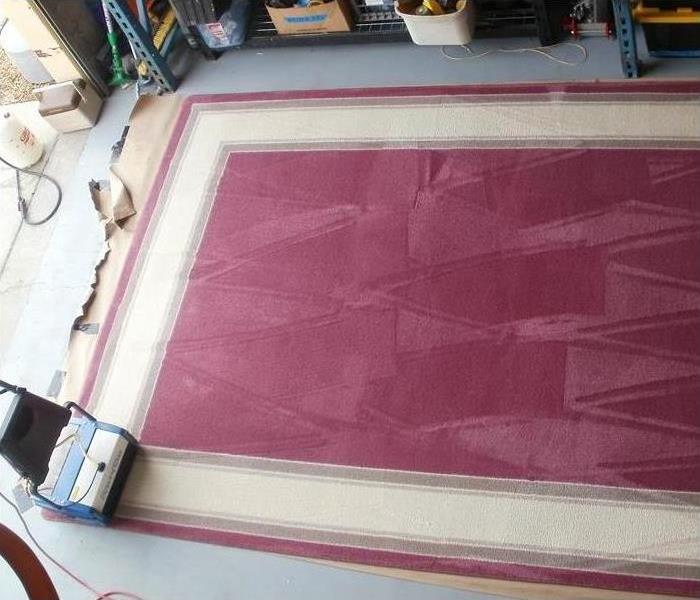Cleaning Wet Items After Water Damage
11/1/2022 (Permalink)
Cleaning Water Damaged Items
Water damage can be a nuisance, but it doesn't have to be a disaster. You can salvage some of your belongings if you act fast and follow recommended cleaning methods. The first step is to separate wet items based on the type of water damage each item has sustained. Then, let clothing air dry prior to packing so that mold doesn't form inside closets or drawers during storage. Finally, disinfect hard surfaces (such as countertops) with a disinfectant cleaner before continuing with restoration efforts.
Dispose of any items that cannot be salvaged.
It's important to note that there are certain items that cannot be salvaged, even if they're cleaned thoroughly. If you're unsure whether an item can be saved, it's best to err on the side of caution and dispose of it. These sorts of items are usually those that are ruined beyond repair or aren't worth the effort needed to clean them well enough for re-use.
If you do decide to throw out a wet item after water damage has occurred (like clothing), make sure you don't save anything else from this damaged area! This will help prevent cross-contamination with other areas where no damage has occurred yet - as well as avoid any possibility for mold growth later down the line due to humidity problems within your house/apartment building structure itself.
Separate items based on the type of water damage they have sustained.
- Damp or wet items that are salvageable should be cleaned and dried immediately. Take these items to a professional cleaner for cleaning and drying, if possible.
- Moldy items (such as carpets, upholstery, textiles, and paper) can be cleaned in most cases by washing with hot water at a commercial laundry service or dry cleaner without using chemicals or bleach. Keep these items out of direct sunlight until they are completely dry.
- Dry-clean only clothing should be taken to an experienced dry cleaner as soon as possible after it has been removed from storage containers to prevent mold growth that could result in permanent staining or discoloring of fabrics or finishes
Allow wet clothing to air dry prior to packing.
Once you've mopped up remaining water and allowed your belongings to air dry, pack your items if possible. You may need to withhold certain items until they're completely dry, like your books or linens. If you can put anything in a suitcase or box, do so immediately.
If you don't have access to a washing machine because of the damage caused by flooding or other water-related issues, place all wet clothing into bags that seal tightly. Place these bags in a closed room with good ventilation and let them sit for 24 hours before opening again (for example: closet). This will help prevent mold from forming on any remaining moisture from inside the bag that wasn't removed during initial drying efforts.
If possible, use fans in conjunction with this method for faster drying times - preferably those that oscillate so as not to cause wrinkles and creases! Remember: Air-drying is best whenever possible as it helps reduce wear-and-tear on fabrics such as jeans/jeans material pants which tend not survive too well in standard washing machines anyway (due primarily due to increase friction caused by rubbing against itself).
Clean hard, non-porous surfaces with a disinfectant cleaner.
When it comes to cleaning hard, non-porous surfaces (like floors, walls, and countertops), you'll need to use a disinfectant cleaner that's approved for use on hard, non-porous surfaces.
You can find these cleaners at your local hardware store or supermarket. Make sure the product is labeled as being effective against germs and bacteria! Most reputable brands will have third party testing results that show their products kill 99.9% of norovirus--the most common cause of foodborne illness--in 30 seconds; if they don't provide this information, find another brand of disinfectant cleaner instead.
You can salvage some items after water damage if you take prompt action and follow recommended cleaning methods.
- Throw it out. If you're not sure if your item can be salvaged, throw it out immediately. You should never risk the health and safety of your family by trying to save something which may have been contaminated with mold.
- Call a professional if possible. If you can't toss something and want an expert opinion on whether it's safe, call an experienced fire restoration company for help! They'll know how to test for mold growth or other hazards associated with wet items and give professional recommendations about how to proceed from there without risking further damage (or worse!).
Water is a powerful force, but it's not unbeatable! This post has given you the tools to clean up your water-damaged home or office. If you find yourself in this situation, take the time to assess the damage and make sure that any salvageable items are properly cleaned before they're put back into service. And don't forget: no matter what happens, always call us first! We'll be there with our expert advice and professional services so that you can start making plans for tomorrow without worrying about today's problems






 24/7 Emergency Service
24/7 Emergency Service
